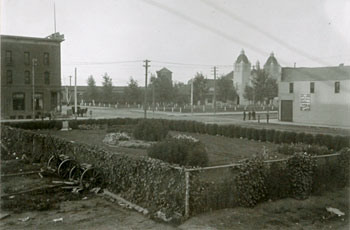
Civic Garden in Bismarck, ND SHSND# E0136In Bismarck in the summer of 1874 interest in garden production ran high. Partly it was stimulated by the controversy ignited by General Hazen’s letter to the New York Tribune. Part of it was pure boomerism. Colonel Lounsberry, editor of the Bismarck Tribune kept tabs on who had land, who was planting what kind of crop, and what the results were. The first to get a spring newspaper notice was Mrs. Joseph Pennell. She was described as a “practical granger” who had planted “with her own hands” a garden that was “creditable alike in size and prospects.” By the time of the May 27 article, her peas were several inches high, beans had sprouted, onions looked “thrifty,” and corn and beets were present.
On June 10, the Tribune reported abundant rainfall, and that the garden of Oscar Ward had large “thrifty” potato vines. E. R. Scott had tomatoes budding in his garden and corn and beans planted two weeks earlier stood four inches high.
By July 8, Oscar Ward was treating his potatoes with Paris Green for a new variety of potato bug. However the rest of his garden was surviving the grasshopper invasion well. Ward had harvested new potatoes, his corn was in tassel, onions were growing, and tomatoes and squashes were blooming and setting. Ward did not irrigate his garden. Another gardener was Mike Smith of Goose Creek. Smith, who was employed by the Northern Pacific Railroad to plant trees along the line, apparently also had a truck garden outside of Bismarck. He brought potatoes to Bismarck a few times in the late summer of 1874. On September 16, Lounsberry stated that Smith’s potatoes “cannot be beaten in any country.”




